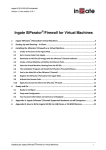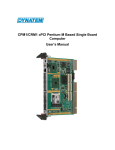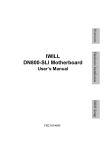Download Iwill MB AMD 8111 8131 Dk8S2 Motherboard
Transcript
IWILL® DK8S2™ High Performance Server Board User ’s Guide FCC Compliance Statement This equipment has been tested and found to comply with limits for a Class B digital device, pursuant to Part 15 of the FCC rules. These limits are designed to provide reasonable protection against harmful interference in residential installations. This equipment generates, uses, and can radiate radio frequency energy, and if not installed and used in accordance with the instructions, may cause harmful interference to radio communications. However, there is no guarantee that interference will not occur in a particular installation. If this equipment does cause interference to radio or television equipment reception, which can be determined by turning the equipment off and on, the user is encouraged to try to correct the interference by one or more of the following measures: 1. Reorient or relocate the receiving antenna 2. Move the equipment away from the receiver 3. Plug the equipment into an outlet on a circuit different from that to which the receiver is connected 4. Consult the dealer or an experienced radio/television technician for additional suggestions You are cautioned that any change or modifications to the equipment not expressly approve by the party responsible for compliance could void Your authority to operate such equipment. This device complies with Part 15 of the FCC Rules. Operation is subjected to the following two conditions 1. This device may not cause harmful interference 2. This device must accept any interference received, including interference that may cause undesired operation. The information in this document is subject to change without notice. IWILL Corp. makes no warranty of any kind with regard to this material, including, but not limited to, the implied warranties of merchantability and fitness for a particular purpose. IWILL Corp. shall not be liable for errors contained herein or for incidental or consequential damages in connection with the furnishing, performance, or use of this material. IWILL Corp. assumes no responsibility for the use or reliability of its software on equipment that is not furnished by IWILL Corp. This document contains proprietary information that is protected by copyright. All rights are reserved. No part of this publication may be reproduced, transcribed, stored in a retrieval system, translated into any language or computer language, or transmitted in any form whatsoever without the prior written consent of IWILL Corp. Copyright© 2003 by IWILL Corp. All rights reserved. Other products and companies referred to herein the trademarks or registered trademarks of their respective companies or mark holders. Printed in Taiwan Revision Version: 1.10 Release Date: May 2003 Contents Chapter 1 1-1 OVERVIEW……………………………………………………..1-1 1.1. Unpacking……………………………………………...1-2 1.2. Features Highlight……………………………………..1-2 1.3. About This User Guide………………………………..1-4 1.4. Getting Help……………………………………………1-5 1.5. DK8S2 Motherboard Layout…………………………1-6 1.6. Motherboard Layout………………………………….1-7 Chapter 2 2-8 HARDWARE INSTALLATION…………………………………...2-8 2.1. Jumper Settings………………………………………..2-9 2.1.1. 2.1.2. 2.1.3. 2.1.4. Clear CMOS Header…………………………………2-10 Enable Onboard VGA Header………………………..2-11 PCI-X Slot Speed Select Header……………………..2-11 PCI-64 Slot Speed Select Header…………………….2-12 2.2. Install Memory……………………………………….2-13 2.2.1. Memory Installation Procedures……………………..2-14 2.3. Install CPU……………………………………………2-16 2.3.1. CPU Installation Procedures…………………………2-16 2.4. Attach Cable to Connectors………………………….2-18 2.4.1. 2.4.2. 2.4.3. 2.4.4. 2.4.5. 2.4.6. ATX Power Supply…………………………………..2-19 Floppy Disk Drive Connector………………………..2-20 Primary IDE connectors……………………………...2-20 Front Panel Switches…………………………………2-21 Front/Back/CPU/Aux Fan Connectors……………….2-23 Rear Panel I/O Ports………………………………….2-24 2.5. Install Expansion Cards……………………………...2-25 2.5.1. Expansion Card Installation Procedure .......................2-25 2.5.2. Assigning IRQs for PCI Expansion Cards...................2-26 2.6. Powering on Your Computer ..................................... 2-27 Chapter 3 3-28 BIOS SETUP………………………………………………….3-28 3.1. Starting BIOS Setup.................................................... 3-29 3.2. Using Setup……………………………………………3-30 3.3. Main Menu……………………………………………3-32 3.4. Advanced Menu........................................................... 3-33 3.4.1. 3.4.2. 3.4.3. 3.4.4. IDE Configuration.......................................................3-34 Super I/O Configuration..............................................3-35 Onboard Device Configuration…………………..…...3-36 The Rest Advanced Setting .........................................3-37 3.5. PCI PnP Menu............................................................. 3-38 3.6. Boot Menu.................................................................... 3-40 3.6.1. Boot Settings Configuration........................................3-41 3.7. Security Menu.............................................................. 3-43 3.8. Chipset Menu............................................................... 3-44 3.8.1. 3.8.2. 3.8.3. 3.8.4. NorthBridge Configuration .........................................3-45 ECC Configuration......................................................3-46 SouthBridge Configuration .........................................3-47 PCI-X Configuration ...................................................3-48 3.9. Power Menu................................................................. 3-50 3.10.Exit Menu.................................................................... 3-51 Chapter 1 Overview Thank you for choosing the DK8S2 high performance Server motherboard. The DK8S2 is a dual AMD® Opteron micro-Socket 940 motherboard (M/B) based on the SSI form factor and is configured with the AMD® HyperTransport I/O Hub 8111 and PCIX Tunnel 8131 chipsets. The board features a Hyper Transport speed of 1600 MT (Mega Transfer per second). For memory support, the DK8S2 provides eight sockets (four + four configuration) accommodating up to 16 GB of memory using registered PC3200/2700/2100 ECC DDR memory modules. Flexibility and expandability are provided by two 64-bit/133MHz PCI-X slots, two PCI 64-bit/66MHz PCI slots, and two 32-bit/33Mhz PCI slots. This array of PCI slots enables numerous add-on cards and provides Peer PCI transaction support to increase system performance. Other optional features such as onboard Silicon Image Serial ATA RAID interfaces (available in DK8S2-SATA), dual INTEL® Gigabit Ethernet controllers, and onboard ATI® RageXL video controller with 8MB memory provide high system capabilities that meet a wide range of demanding server applications. 1-1 1.1. Unpacking Remove all items from the box and make sure you have these following items: 1. 2. 3. 4. 5. 6. 7. 8. One DK8S2 motherboard Two ATA 100 IDE ribbon cable (one piece in DK8S2-SATA) One floppy ribbon cable One bag of spare jumpers One CD containing drivers and utilities One DK8S2 User Guide Four Serial ATA ribbon cable (available in DK8S2-SATA) Two Serial ATA power cable (available in DK8S2-SATA) If you discover damaged or missing items, please contact your retailer. 1.2. Features Highlight CPU 1. 2. Chipset 1. 2. 1-2 System Memory Support 1. Expansion Slots 1. 2. Supports dual AMD® Opteron Socket 940 CPUs at 1600 MT per second. Built-in Memory Controller Hub (MCH) Uses the latest AMD® 8111 Hyper Transport I/O hub and 8131 PCI-X Tunnel DK8S2 supports the newest technologies: 32bit/33MHz PCI slots, 64bit/66MHz and 64 bit/133MHz PCI-X slots, USB interface, Peer PCI Transaction 2 and I C Bus support and more. DK8S2 provides 4+4 DIMM sockets and supports total system memory size up to 16GB. Select from PC3200/2700/2100 ECC DDR registered DIMM Provides two PCI-32-bit/33MHz, two PCI 64-bit/66MHz, and two PCI-X-64bit/133Mhz expansion slots 2. 64-bit/66MHz PCI technology enables bandwidth up to 528MB/s. ATI® RageXL video controller with 8MB memory Onboard Chip VGA Onboard LAN Dual Dual Onboard Intel® 82541EI Gigabit Super Multi-I/O Floppy Drive Serial ATA RAID (available in DK8S2-SATA) System Management PC99 Compliant Dimension Ethernet controllers. 1. Winbond super I/O W83627HFAW 2. One UART 16550 serial port 3. One external serial port 4. Dual onboard USB 1.1 connectors 5. Four extendable USB 1.1 connectors by headers 6. PS/2 mouse and keyboard connectors with Wake-up function Supports 3.5” (1.44MB or 2.88MB) floppy drive and Japanese standard “Floppy 3 mode” (3.5” disk drive: 1.44MB, 1.2MB, 720KB) and LS-120 floppy disk drives (3.5” disk drive: 120 MB). BIOS supports IDE CD-ROM boot-up. 1. Four Integrated Silicon Image Sil3114 Serial ATA ports 2. Support RAID 0, 1, 0+1 1. AMC connector for IWILL Server Remote Management Controller card (ISRM) (optional) 2. IPMI 1.5 (optional with ISRM) 3. Prevent from abnormal system down/data loss 4. Alert on LAN ready 5. Remote system controller ready The DK8S2 is fully compliant with the Microsoft PC99 specification at both the hardware and BIOS levels. Extended SSI form factor-12”x13” 1-3 1.3. About This User Guide This manual explains how to build your system with DK8S2 in detail. Please follow the procedures of this User Manual carefully and pay special attention to these icons. IMPORTANT WARNING NOTE TIP 1-4 This icon informs you for particularly important details regarding the setup or maintenance of your system. While we point out the most vital paragraphs in a chapter, you should always read every word carefully. Failing to do so can cause exasperation. This icon alerted you for potential dangers during setting up your system with DK8S2. These warnings should not be regarded as the whole of your safety regimen. Never forget that computer are electronic devices and are capable of delivering a shock. Prevent damage to yourself and to your board: always ensure that your system is turned off and unplugged the power cords whenever you are working with it, and that you are equipped This icon alerted you for notice during setting up your system. It provides you can useful alert during setting up a new system. This icon will show you how to configure your system with DK8S2 in an easy and simple ways. This icon always provides some useful description to help you configure your system. 1.4. Getting Help If a problem arises with yours system during Installation or OS operating, you should ask your dealer for help first as your system has most likely be configured by them. They always have the best idea and quick response for your symptoms. If your dealer is near to your locations, you should bring your system to them to have it quickly serviced instead of attempting to solve the problem by yourself. 1. Go to IWILL website at www.iwill.net and navigate to this product page which contain links to product updates such as Jumper settings or BIOS updates. 2. FAQ sections on IWILL Website are often helpful since other user's questions are often your own. 3. Email us at: [email protected] and we will try to answer your questions within 24 hours. 1-5 1.5. DK8S2 Motherboard Layout Figure 1-1: Motherboard features ATI Rage XL LAN1 VGA LAN2 COM 1 USB Mouse Keyboard COM 2 CPU 1 IPMI Connector PCI 32 Memory DIMM 2,3,0,1 PCI 64 PCI-X 133/100 Power AMD 8111 AMD 8131 Slim Floppy CPU 0 Floppy IDE1,IDE0 Memory DIMM 1,0,3,2 Silicon Image S-ATA Chip S-ATA Port 4,2,1,3 1-6 (Available in DK8S2-SATA) 1.6. Motherboard Layout Figure 1-2: Motherboard layout NOTE Refer to page 2-24 for the I/O port array layout. 1-7 Chapter 2 Hardware Installation In this chapter, the Installation of the DK8S2 with the processor and other hardware connected to your system is explained in detail. Installation Procedures Installation procedures will be broken up into six major parts. Step 1: Set jumpers Step 2: Install memory (DDR memory modules) Step 3: Install AMD® Opteron CPU Step 4: Attach cables to connectors Step 5: Install expansion cards Step 6: Connect power WARNING This motherboard contains sensitive electronic components that can be easily damaged by static electricity. Follow the instructions carefully to ensure correct Installation and to avoid static damage. 2-8 2.1. Jumper Settings This section covers the DK8S2 jumper settings. Refer to the following illustration for the location of the DK8S2 jumpers. Figure 2-1: DK8S2 jumpers 2-9 2.1.1. Clear CMOS Header The onboard button cell battery powers the CMOS RAM. It contains all the BIOS setup information. Normally, it is necessary to keep the jumper connected to pin2 and pin3 (Default) to retain the RTC data as shown below. 1 2 3 1-2 CMOS enable (default) 1 2 3 2-3 clear CMOS Figure 2-2: DK8S2 clear COMS header Follow these instructions to clear the CMOS RTC data: 1. 2. 3. 4. 5. 2-10 Turn off your computer. Short pin2 and pin3 with a jumper for a few seconds. Replace the jumper on pin1 and pin2. Turn on your computer by pressing the power-on button. Hold down <Delete> during boot and select either the <Load Optimal Defaults> or <Load Failsafe Defaults> option in the selection "Exit". Then re-enter BIOS setup to re-enter user preferences. Refer to Chapter 2 BIOS SETUP for more information. 2.1.2. Enable Onboard VGA Header If you are going to use the onboard VGA feature, you must enable the onboard VGA header. Refer to the following illustration: 1 2 3 1-2 VGA enable (default) 1 2 3 2-3 disable VGA Figure 2-3: Onboard VGA header 2.1.3. PCI-X Slot Speed Select Header This header lets you determine the bus speed of the PCI-X slots. The speed can be set to either 133 MHz or 100 MHz (default). Refer to the following illustration: 1 2 3 1 2 3 1-2 PCI-X 133 MHz enable 2-3 PCI-X 100 MHz enable (default) Figure 2-4: PCI-X speed selection 2-11 2.1.4. PCI 64-bit Slot Speed Select Header This header lets you determine the bus speed of the PCI 64-bit slots. The speed can be set to either 64 MHz (default) or 33 MHz. Refer to the following illustration: Figure 2-5: PCI 64-bit speed selection 2-12 2.2. Install Memory DK8S2 uses Dual Inline Memory Modules (DIMM). Two 4-DIMM socket banks are available, each bank supporting one CPU socket. The DIMM sockets accommodate PC2100/2700/3200 (DDR266/DDR333/DDR400) and Double Data Rate Memory (DDR) memory modules in 128MB, 256MB, 512MB, 1GB, and 2GB combinations. Total memory size is between 128MB and 16GB. IMPORTANT The DK8S2 motherboard has strict memory type and timing requirements. Before you buying DDR DIMM (Double Data Rate) for use in the DK8S2, consult your local reseller to advise you of the best memory to use with the DK8S2. DK8S2 only supports Registered PC3200/2100/2700 (DDR400/DDR333/DDR266) compliant modules. You must populate HO DIMM modules 0~3 before the H1 modules 0~3. 2-13 2.2.1. Memory Installation Procedures 1. Locate the DIMM modules on the DK8S2. H1 DIMM modules 0 ~ 3 2 3 0 1 H0 DIMM modules 0 ~ 3 1 0 3 2 Figure 2-6: Installing memory modules 2. Ensure that the DIMM module's pins face down and match the socket's size as shown in Figure 8. 80 pins 104 pins Figure 2-7: Memory module pin arrangement 2-14 3. 4. Insert the module down to the DIMM socket in with both hands and press down firmly until the DIMM module is securely in place. The tabs of the socket will close-up to hold the DIMM in place when the DIMM touches the socket's bottom. Repeat steps 1 to step 3 to add additional DIMM modules. H0 DIMM 2 H0 DIMM 3 H0 DIMM 0 H0 DIMM 1 IMPORTANT 1. 2. You have to insert two memory modules in DIMM 0/1 slots or DIMM 2/3 slots when you install modules; otherwise you will not be able to boot the system. Ensure that you populate HO DIMM slots before inserting memory modules in the H1 DIMM slot bank. 2-15 2.3. Install CPU DK8S2 accommodates AMD® Opteron micro-PGA Socket 940 processors at 1600 MT (Mega Transfer per second). You must first insert a CPU into CPU socket 0 (CPU0) before installing one in CPU socket 1 (CPU1). 2.3.1. CPU Installation Procedures Follow these instructions to install a CPU. 1. Locate the pin 1 of the CPU socket and pin 1 of the CPU. Pin 1 Figure 2-8: CPU pin 1 location 2. Lift up the socket lever (A) and place the Socket 940 CPU with the correct orientation (B) as shown in the following illustrations. Align the pin 1 of the CPU with pin 1 of the socket. 3. 4. 5. 2-16 Lower the socket-locking lever into place. Apply thermal grease to the top of the CPU. Mount the CPU heatsink to the top of the CPU and socket as shown in the following illustration. Secure one motherboard side to the fan Secure the opposite side power cable Repeat these steps to install the CPU1. connector YELLOW 7. into RED Plug the 3-wire FRONT_FAN1 BLACK 6. 2-17 2.4. Attach Cable to Connectors This section covers connecting devices to the DK8S2. The following illustration shows the location of the connectors. Figure 2-9: Connector location 2-18 2.4.1. ATX Power Supply These 24-pin connectors connect the mainboard to the ATX power supply. Find the proper orientation and push down firmly to make sure that the pins are aligned. The 8-pin connector provides a dedicated power supply for the CPUs. For Wake on LAN support, 5-volt Stand-by lead (+5VSB) from ATX power supply must supply at least 2A. 24-pin power supply connector +3.3V +3.3V +3.3V COM -12V +5V COM +5V COM PS_ON COM COM COM PWR_OK COM 5VSB +5V +5V +5V COM +12V +12V 3.3V Reserved 8-pin power supply IMPORTANT IWILL always recommends our customers use ATX Power that has more than 300W power capacity and is compatible with the Intel ATX 2.03 specification. 2-19 2.4.2. Floppy Disk Drive Connector This 34-pin connector supports the provided floppy disk drive ribbon cable. After connecting the single end to the board, connect the plug on the other end to the floppy drive. 34-pin FDD connector Pin 1 Slim type FDD connector 2.4.3. Primary IDE connectors These two 40-pin IDE connectors support 40-wire IDE hard disk ribbon cables (provided). After connecting the single end to the board, connect the two plugs at the other end to your hard disk(s). If you connect two hard disks to the same cable, you must configure the second drive to Slave mode by setting its jumpers. Refer to the documentation of your hard disk for the jumper settings. BIOS now support IDE HDD or IDE CD-ROM boot-up (Pin 20 is removed to prevent inserting in the wrong orientation when using ribbon cables with pin 20 plugged in). Support for Ultra DMA 33/66/100 is also featured in the BIOS. IMPORTANT Ribbon cables should always be connected with the red stripe on the Pin 1 side of the connector. IDE ribbon cables must be less than 46 cm (18 inches) long, with the second drive connector no more than 15 cm (6 inches) from the first connector. 2-20 40-pin IDE connectors Pin 1 IDE 1 IDE 2 2.4.4. Front Panel Switches The front panel switches header connects the power button, front panel speaker, reset button, and power/HDD/SCSI LEDs to the motherboard. 2-21 The switches are described as follows. * Reset Switch (2-pin RST) This 2-pin connector connects to the case-mounted reset switch for rebooting your computer without turning off and on your power switch. This is a preferred method of rebooting to prolong the life of the system's power supply. SCSI Hard disk Card Activity LED (4-pin SCSI_HD) The 4-pin connector can be connected to the 4-pin activity LED connector of SCSI card Read and Write activities by devices connected to the SCSI card will cause the front panel LED to light up. Hard Disk Activity LED (2-pin HDD_LED) This connector supplies power to the cabinet's hard disk or IDE activity LED. Read and write activity by devices connected to the Primary or Secondary IDE connectors will cause the LED to light up. Speaker Connector (4-pin SPEAKER) There is one jumper cap over pin1 and pin2 (default setting) for internal buzzer. If you want to use external case-mounted speaker instead of internal buzzer, remove jumper cap and connect speaker wire to the 4-pin connector. ATX Power Switch / Soft Power Switch (2-pin PWR_SW) A momentary switch connected to these connector controls the system power. Pressing the button once will switch the system between ON and SLEEP. The system power LED shows the status of the system's power. System Power LED (3-pin PWR_LED) This 3-pin connector connects the system power LED, which lights up when the system is powered on. 2-22 2.4.5. Front/Back/CPU/Aux Fan Connectors There are nine 3-pin fan connectors in the DK8S2 motherboard. Two fans are used for CPU0 and CPU1; seven are for auxiliary power. These connectors support cooling fans of 500mA (6W) or less. Depending on the fan manufacturer, the wiring and plug may be different. Connect the fan's plug to the board taking into consideration the polarity of this connector. WARNING The CPU and/or motherboard will overheat if there is not enough airflow across the CPU and onboard heatsink. Damage may occur to the motherboard and/or the CPU fan if these pins are incorrectly used. These are not jumpers; do not place jumper caps over these pins. NOTE 9 The "Rotation" signal has to be used with fan specially designed with rotation signal. 9 Only the fan marked Front_Fan1, Front_Fan0, H0_Fan1, H0_Fan1, H1_Fan0 and H1_Fan1 can be monitored by BIOS. 2-23 2.4.6. Rear Panel I/O Ports The following illustration displays the motherboard I/O port array. Figure 2-10: I/O port array These ports are described as follows. PS/2 Mouse Connector (6-pin Female) The system will direct IRQ12 to the PS/2 mouse if one is detected. If not detected, expansion cards can use IRQ12. PS/2 Keyboard Connector (6-pin Female) This connection is for a standard keyboard using a PS/2 plug (mini DIN). This connector will not allow standard AT size (large DIN) keyboard plugs. You may use a DIN to mini DIN adapter on standard AT keyboards. Universal Serial BUS Ports I & 2 (Two 4-pin Female) Two external USB 1.1 ports onboard are available for connecting 2 USB devices. Serial Port 1 Connector (9-pin Male) The serial port COM1 can be used for pointing devices or other serial devices. See the BIOS Setup. VGA Connector (15-pin Female) The VGA port connects display device. See the BIOS Setup. Parallel Printer Connector (25-pin Female) You can enable the parallel port and choose the IRQ through the BIOS Setup. Only with Parallel SKU. Onboard LAN Ports (RJ-45) DK8S2 uses Intel® 82541 EI Gigabit Ethernet Controller. It consists of both the Media Access controller and Mbps Physical Layer (PHY) interface. Please refer to the "Onboard LAN User Guide" for further information. 2-24 9-pin onboard COM 2 header Onboard USB 0 header USB pin assignment PIN Onboard USB 1 header Description 1 VCC 2 DATA– 3 DATA+ 4 GROUND 5 NC 2.5. Install Expansion Cards WARNING Power off your power supply completely when adding removing any expansion cards or other system components. Failure to do so may cause severe damage to both your motherboard and expansion cards. 2.5.1. Expansion Card Installation Procedure Read the documentation for your expansion card and make any necessary hardware or software setting changes, such as jumpers. 1. 2. 3. 4. Remove the bracket plate on the slot you intend to use. Keep the bracket for possible future use. Carefully align the card's connectors and press firmly. Secure the card on the slot with the screw you removed above. Jump to step 6 to finish Installation, then set the IRQ and DMA as follows. 2-25 2.5.2. Assigning IRQs for PCI Expansion Cards An IRQ number is automatically assigned to PCI expansion cards. In the PCI bus design, the BIOS automatically assigns an IRQ to a PCI slot that contains a card requiring an IRQ. To install a PCI card, you need to set the INT (interrupt) assignment. Since all the PCI slots on this motherboard use an INTA #, set the jumpers on your PCI cards to INTA. 2-26 2.6. Powering on Your Server Follow these instructions to power on the computer after you have installed the motherboard. 1. 2. 3. 4. 5. 6. Be sure that all switches are off (in some systems, marked with "O"). After finishing all jumper settings and connections, close the system case cover. Connect the power supply cord in the power supply located on the back of your system case and connect the other end of the power cord into a power outlet that is equipped with a surge protector. Turn on your devices in the following order: − Monitor − External SCSI devices (starting with the last device on the chain) − System power. For ATX power supplies, you need to switch on the power supply as well as press the ATX power switch on the front of the case. The power LED on the front panel of the system case will light up. For ATX power supplies, the system LED will light up when the ATX power switch is pressed. The monitor LED may light up after the system's LED if it complies with "green" standards or if it has a power standby feature. The system will then run power-on tests. While the tests are running, additional messages will appear on the screen. If you do not see anything within 30 seconds from the time you turn on the power, the system may have failed a power-on test. Recheck your jumper settings and connections or call your retailer for assistance. During power-on, hold down <Delete> to enter BIOS setup. Follow the instructions in the next chapter, BIOS Setup. NOTE Powering Off your computer. You have to first exit or shut down your operating system before switching off the power switch. For ATX power supplies, you can press the ATX power switch after exiting or shutting down your operating system. 2-27 Chapter 3 BIOS Setup This chapter discusses the AMI BIOS Setup program built into the ROM BIOS. The Setup program allows users modifying the basic system configurations according to their requirements. This special information is then stored in battery-backed RAM so that it retains the Setup information when the power is turned off. The AMI BIOS installed in your computer system's ROM (Read Only Memory) is a custom version of an industry standard BIOS. The BIOS provides critical low-level support for standard devices such as disk drives and serial and parallel ports. The AMI BIOS has been customized by adding important, but nonstandard, features such as password protection as well as special support for detailed fine-tuning of the chipset controlling the entire system. The rest of this chapter is intended to guide you through the process of configuring your system using Setup. 3-28 3.1. Starting BIOS Setup The AMI BIOS is immediately activated when you power on the computer every time. The BIOS reads the system information contained in the CMOS and begins the process of checking out the system and configuring it. After finishing configuring the whole system, then BIOS will continue to seek an operating system on one of the disks, launch then turn control over to the operating system. While the AMI BIOS is in control, the Setup program can be activated in the way: By pressing the <F2> key when the following message appears briefly at the bottom of the screen during the POST (Power On Self-Test). Press <F2> to enter SETUP. 3-29 3.2. Using Setup In general, you use the arrow keys to highlight items, press <Enter> to select, press <Esc> to quit. The following table provides more details about how to navigate in the Setup program using the keyboard. Key Function Up Arrow(Ç) Key Down Arrow(È) Key Left Arrow(Å) Key Right Arrow(Æ) Key Esc key Move to the previous item Move to the next item Move to the previous item Move to the next item In the Submenu: Exit the submenu. In the BIOS main category: Quit Without saving changes. Enter Key Select the item. A pop-up selection will display on the screen to set the item value. Previous page on Scrollable menus or jump to the first interactive item listed PgUp Key PgDn Key Next page on Scrollable menus or jump to the last interactive item listed F1 Key F2/F3 Key General Help on Setup navigation keys. Press <F1> key to pop up a small help window that describes the appropriate keys to use and the possible selections for the highlighted item. To exit the Help Window, press <ESC> key or <F1> key again. Change colors F7 Key F8 Key F9 Key F10 Key Home End Esc Discard changes Load failsafe defaults Load optimal defaults Save and Exit Go to top of screen Go to bottom of screen Exit IMPORTANT The BIOS does NOT automatically save values that you have modified. If you 3-30 do not save your values before you exit the BIOS Setup Utility, all your changes will be lost. If after making and saving system changes with the BIOS Setup Utility, you discover that your computer is no longer able to boot, the AMI BIOS supports an override, which will reset your system to the Failsafe defaults. If that fails, it is possible to manually clear the present CMOS information through the "Clear CMOS Header" on the motherboard (Refer to Jumper Settings for more information). The best advice is to ONLY alter settings which you thoroughly understand. The default settings have been carefully chosen by AMIBIOS to provide the maximum system performance and reliability. Even a slight change to the chipset setup may cause potential and unpredictable failure to the system. 3-31 3.3. Main Menu This is the first screen that is displayed when you enter the BIOS Setup Utility. Each tab lined on the top of the screen represents each different menu. The following picture shows the main menu. Main menu shows the information of BIOS version, date and ID; processor type, speed and count; system size. In addition, system time and date is adjustable using + / - key or number keys. 3-32 3.4. Advanced Menu You can make these modifications on the Advanced menu. 3-33 3.4.1 IDE Configuration You can make the selections on IDE Configuration menu. Feature Options Description OnBoard PCI IDE Controller Disable Primary Secondary Both Disable: disable the integrated IDE controller Primary: enable only the Primary IDE controller Secondary: enable only the Secondary IDE controller Both: enable both IDE controllers Hard Disk Protect Disable Enable Disable/Enable the hard disk write protection. This will be effective only device is accessed through BIOS IDE Detect Time out (sec) 0, 5, 10, 15, 20, 25, 30, 35 Select the time out value for detecting ATA/ATAPI device ATA (PI) 80Pin Cable Detection Host & Device Host Device Select the mechanism for detecting 80 pin cable 3-34 Write 3.4.2 Super I/O Configuration You can make the selections on Super I/O Configuration menu. Feature Options Description Onboard Game/Midi Port Disabled Allows BIOS to enable or disable floppy controller Onboard Game/Midi Port Keyboard PowerOn Function Enabled Disabled 200/300, 200/330 Allows BIOS to enable or disable Game/Midi port 208/300, 208/330 Disabled Any Key 3-35 3.4.3 Onboard Device Configuration You can make the selections on Onboard Device Configuration. Feature Onboard Controller SATA Description Enabled Enabled: Support Serial ATA function Disabled Onboard SATA Mode Setting Onboard 1 GIGA NIC Onboard 2 GIGA NIC Options st nd Intel RAID Enabled: Support RAID SATA 0, 1, 0+1 Enabled Disabled Intel Enabled Disabled (Note: SATA function is only available in DK8S2-SATA.) 3-36 3.4.4 The Rest Advanced setting Feature Options Description Floppy Configuration Disabled 5 1/2” 360 KB 5 1/2” 1.2 MB 3 1/2” 720 KB 3 1/2” 1.44 MB 3 1/2” 2.88 MB Select Floppy A or Floppy B and then selects floppydiskette type installed in your system. Hardware Health Configuration Disable/Enable hardware health function and hardware thermal throttling Enable/Disable hardware health function Thermal throttling allows the user to reduce CPU duty cycle to a user defined percentage when the temperature reaches a user defined value H/W health event ACPI Configuration ACPI Aware O/S Yes/No Enable: O/S supports ACPI Disable: O/S doesn’t support ACPI Hyper Transport Configuration CPU0 : CPU1 HT Link Speed/Width Hyper Transport link speed/width is adjustable Remote Access Configuration Disable Serial Selects Remote Access type USB Configuration Legacy USB Support Disabled/Enabled/A uto USB Mass Storage Device Configuration Enable support for legacy USB Auto option disables legacy support it no USB device connected Configure the USB mass storage class devices 3-37 3.5. PCI PnP Menu Feature Options Description Plug & Play O/S Yes No Yes: lets the O/S configure PnP devices not required for boot if your system has a Plug and Play O/S PCI Latency Timer 32, 64, 96, 128, 160, 192, 224, 248 Value in units of PCI clocks for PCI device latency timer register 3-38 Allocate IRQ to PCI VGA Yes No Yes: Assign IRQ to PCI VGA card if card requests IRQ No: Doesn’t assign IRQ To PCI VGA cars even if card requests IRQ Palette Snooping Enabled Disabled Enabled: informs the PCI devices that an ISA graphics device is installed in the system so the card will function correctly PCI IDE BusMaster Enabled Disabled Enabled: BIOS uses PCI busmastering for reading/writing to IDE drives Offboard IDE card Auto Some PCI IDE cards may require this to be set to the PCI slot number that is holding the card PCI/ISA PCI Slot1 PCI Slot2 PCI Slot3 PCI Slot4 PCI Slot5 IRQ3~IRQ15 Available Reserved Available: specified IRQ is available to be used by PCI/PnP devices Reserve: specified IRQ is reserved for use by legacy ISA devices DMA Channel 0, 1, 3, 5, 6, 7 Available Reserved Available: specified DMA is available to be used by PCI/PnP devices Reserve: specified DMA is reserved for use by legacy ISA devices Reserved Size Memory Disabled 16K 32K 64K Size of memory block to reserve for legacy ISA devices 3-39 3.6. Boot Menu Feature Description Boot Device Priority Specify the boot device priority sequence Hard Disk Drives Specify the boot device priority sequence from available hard drives Removable Drives Specify the boot device priority sequence from available removable drives ATAPI CDROM Drives Specify the boot device priority sequence from available ATAPI CDROM drives 3-40 3.6.1 Boot Settings Configuration Feature Options Description Quick Boot Disabled Enabled Allow BIOS to skip tests while booting Quiet Boot Disabled Enabled Disabled: Display normal POST messages Enabled: Display OEM logo Add-on ROM Display Mode Force BIOS Set display mode for option ROM Bootup Num-Lock Off Keep Current On PS/2 Mouse Support Disabled Typematic Rate Slow Enabled Fast System Keyboard Absent Present Parity Check Disable Enable Select power on state for Num-Lock Select support for PS/2 mouse Select keyboard typematic rate Enable/Disable all keyboards attached to the system Enable/Disable memory or parity error check 3-41 Boot to OS/2 No OS/2 compatibility mode Yes Wait for “ F1 “ if error Disabled Hit “ DEL “ Message Display Disabled Interrupt 19 Capture Disabled Enabled Enabled Enabled 3-42 Wait for F1 key to be pressed if error occurs Display “ Press DEL to run Setup “ in POST Enabled: allows option ROMs to trap interrupt 19 3.7. Security Menu Feature Options Description Change User Password Install or password Clear User Password Setup: check password while invoking setup Always: check password while invoking setup as well as on each boot Boot Sector Virus Protection Disabled Enabled change the Enable/Disable boot sector virus protection 3-43 3.8. Chipset Menu 3-44 3.8.1 NorthBridge Configuration Feature Options Description Bank Interleaving Auto Disabled Interleaving allows memory accesses to be spread out over BANKS on the same node, or across NODES, decreasing access contention Node Interleaving Auto Interleaving allows memory accesses to be spread out over BANKS on the same node, or across NODES, decreasing access contention Disabled Burst Length 8 Beats 4 Beats Burst length can be set to 8 or 4 beats. 64 bit Dq must use the 4 beats 3-45 3.8.2 ECC Configuration Feature Options Description Master ECC Enable Disabled Enabled Master ECC Enables support on all nodes for ECC error detect and correction 3-46 3.8.3 SouthBridge Configuration Feature Options 2.0 SM Bus Controller Disabled Enabled HT Link 0 P-Comp Mode HT Link 0 N-Comp Mode HT Link 0 RZ-Comp Mode Auto Data Calcomp + Data Calcomp - Data Description Auto causes hardware compensation vales. Other choices allow the user to override default compensation with an absolute value, add to the hardware generated value, or subtract a value from the generated value 3-47 3.8.4 PCI-X Configuration Feature Options Description HT Link 0 P-Comp Mode Auto Data Calcomp+Data Calcomp-Data Auto causes hardware compensation values. HT Link 0 N-Comp Mode Auto Data Calcomp+Data Calcomp-Data Auto causes hardware compensation values. HT Link 0 NZ-Comp Mode Auto Data Calcomp+Data Calcomp-Data Auto causes hardware compensation values. 3-48 HT Link 1 P-Comp Mode Auto Data Calcomp+Data Calcomp-Data Auto causes hardware compensation values. HT Link 1 N-Comp Mode Auto Data Calcomp+Data Calcomp-Data Auto causes hardware compensation values. HT Link 1 NZ-Comp Mode Auto Data Calcomp+Data Calcomp-Data Auto causes hardware compensation values. 3-49 3.9. Power Menu Feature Options Description Change User Password Install or password Clear User Password Setup: check password while invoking setup Always: check password while invoking setup as well as on each boot Boot Sector Virus Protection 3-50 Disabled Enabled change the Enable/Disable boot sector virus protection 3.10. Exit Menu Feature Description Save Changes and Exit Exit system setup after saving the changes F10 key can be used for this operation Discard Changes and Exit Exit system setup without saving the changes ESC key can be used for this operation Discard Changes Discard changes done so far to any of the setup question F7 key can be used for this operation Load Optimal Defaults Load optimal default values for all the setup questions F9 key can be used for this operation Load Failsafe Defaults Load Failsafe default values for all the setup questions F8 key can be used for this operation 3-51

































































